
Tudela is a municipality in Spain, the second largest city of the autonomous community of Navarre and twice a former Latin bishopric. Its population is around 35,000. The city is sited in the Ebro valley. Fast trains running on two-track electrified railways serve the city and two freeways join close to it. Tudela is the capital of the agricultural region of Ribera Navarra, and also the seat of the courts of its judicial district.

Ourense is a city and capital of the province of Ourense, located in the autonomous community of Galicia, northwestern Spain. It is on the Camino Sanabrés path of the Way of St James, and is crossed by the Miño, Barbaña, Loña and Barbañica rivers. It is also known as A cidade das Burgas due to its hot springs, being one of the European cities with the greatest thermal heritage.
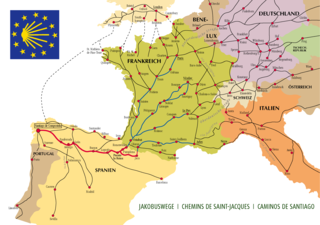
The Camino de Santiago, known in English as the Way of St James, is a network of pilgrims' ways or pilgrimages leading to the shrine of the apostle Saint James the Great in the cathedral of Santiago de Compostela in Galicia in northwestern Spain, where tradition holds that the remains of the apostle are buried.
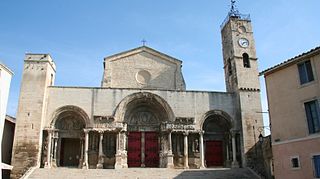
Saint-Gilles or Saint-Gilles-du-Gard is a commune in the Gard department in southern France.

Roncesvalles is a small village and municipality in Navarre, northern Spain. It is situated on the small river Urrobi at an altitude of some 900 metres (3,000 ft) in the Pyrenees, about 4 kilometres (2.5 mi) from the French border as the crow flies, or 21 kilometres (13 mi) by road.
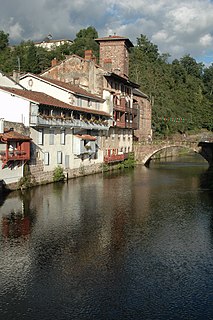
Saint-Jean-Pied-de-Port is a commune in the Pyrénées-Atlantiques department in south-western France. It is close to Ostabat in the Pyrenean foothills. The town is also the old capital of the traditional Basque province of Lower Navarre. Saint-Jean-Pied-de-Port is also a starting point for the French Way Camino Francés, the most popular option for travelling the Camino de Santiago.

Estella (Spanish) or Lizarra (Basque) is a town located in the autonomous community of Navarre, in northern Spain. It lies south west of Pamplona, close to the border with La Rioja and Álava.

The Camino de Santiago, also known as the Way of St. James, extends from different countries of Europe, and even North Africa, on its way to Santiago de Compostela and Finisterre. The local authorities try to restore many of the ancient routes, even those used in a limited period, in the interest of tourism.
The Aragonese Way is a route of the Way of St. James beginning at the French-Spanish border at the pass of Somport and joining the French Way at Puente la Reina in Navarre. It is the continuation of the Arles Way which begins in Arles and crosses the Pyrenees into Spain at Somport.
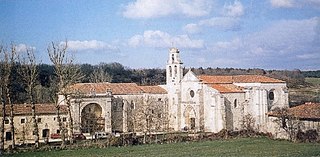
The old monastery of San Juan de Ortega is a Romanesque monument in Barrios de Colina, in the province of Burgos, Spain.

Sangüesa is a city in Navarre, Spain, 44.5 kilometers from Pamplona. It lies close to the River Aragon and in 2007 had a population of 5,128. It is located on the Way of Saint James. It has been an important stopping point for pilgrims since the Middle Ages and has preserved its medieval character.

The French Way is the GR 65 and the most popular of the routes of the Way of St. James, the ancient pilgrimage route to Santiago de Compostela in Galicia, Spain. It runs from Saint-Jean-Pied-de-Port on the French side of the Pyrenees to Roncesvalles on the Spanish side and then another 780 km on to Santiago de Compostela through the major cities of Pamplona, Logroño, Burgos and León. A typical walk on the Camino francés takes at least four weeks, allowing for one or two rest days on the way. Some travel the Camino on bicycle or on horseback.
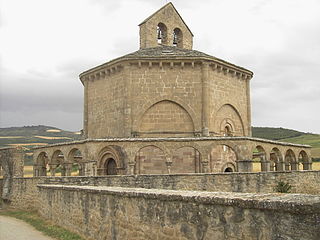
The Church of Saint Mary of Eunate is a 12th-century Catholic church of Romanesque construction located about 2 km south-east of Muruzábal, Navarre, Spain, on the Way of Saint James. Its origins are disputed due to lack of documentation. Its octagonal plan and the fact that it is not located in a present-day village or town but in the countryside contribute to its enigmatic nature. It is a site on the French Way path of the Camino de Santiago.
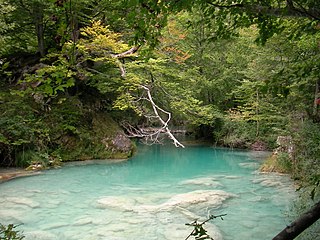
Urederra is the natural exit of the aquifer created in the rock massif karst of Urbasa, Navarre. The river rises in The Natural Park of Urbasa-Andía, near the village Baquedano. It is 19 km long and flows into the Ega River, which is a tributary of the Ebro. The first emerge is produced in a 713 metres high clift in the southern ledge of the rock massif and makes a more than 100 metres waterfall which with the passing of the years has modelled a rocky and karstic landscape.
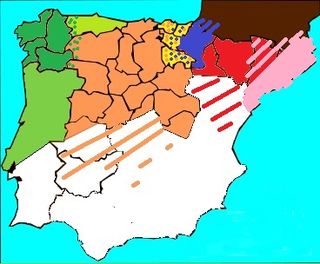
Spanish Romanesque designates the Romanesque art developed in the Hispanic-Christian kingdoms of the Iberian Peninsula in the 11th and 12th centuries. Its stylistic features are essentially common to the European Romanesque although it developed particular characteristics in the different regions of the peninsula. There is no Romanesque art in the southern half of the peninsula because it remained under Muslim rule (Al-Andalus). The examples of Romanesque buildings in the central area of the peninsula are sparse and of the latest period, with virtually no presence south of the Ebro and the Tagus. Most Romanesque buildings can be found in the northern third of the peninsula. Romanesque art was introduced into the peninsula from east to west, so scholars have usually defined regional characteristics accordingly: the "eastern kingdoms" comprising the Pyrenean areas, Catalan Romanesque, Aragonese Romanesque and Navarrese Romanesque, and the "western kingdoms" comprising Castilian-Leonese Romanesque, Asturian Romanesque, Galician Romanesque and Portuguese Romanesque.

The Carlist Party of Euskal Herria, before 2000 known as the Carlist Party of Euskadi, is a left-wing Carlist Basque political party with presence in the Spanish Basque Country. The party was historically part of the pro-Carlos Hugo wing of the Carlist movement. The party was not legalized until late 1977.

The Citadel of Pamplona or The New Castle is an old military renaissance fort, constructed between the 16th and 17th centuries in the city of Pamplona, the capital of the Navarre Community (Spain). At present a large part of the fort it is still standing in a public park with cultural activities taking place in its buildings.
The Gamazada is the popular reaction in Navarre in 1893 and 1894 to when the Spanish finance minister of the Liberal Party under Prime Minister Sagasta, Germán Gamazo, tried to suppress the fueros that had been established in the Compromise Act of 1841. It caused a huge uproar among the people and institutions of Navarre, with demonstrations and petitions.
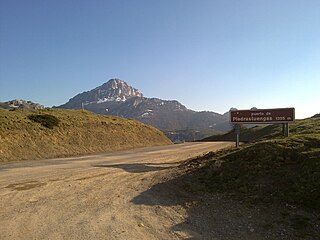
The Camino Real de la Valdavia is a historical route in Spain that joins the Way of St. James as it passes through Carrión de los Condes, with the Piedrasluengas pass through the valley of the Valdavia, and which was known and represented as such on maps until recent times.
Otano, known in Basque as Otao, is a hamlet located in the municipality of Noáin, in Navarre province, Spain. As of 2020, it has a population of 7.
















